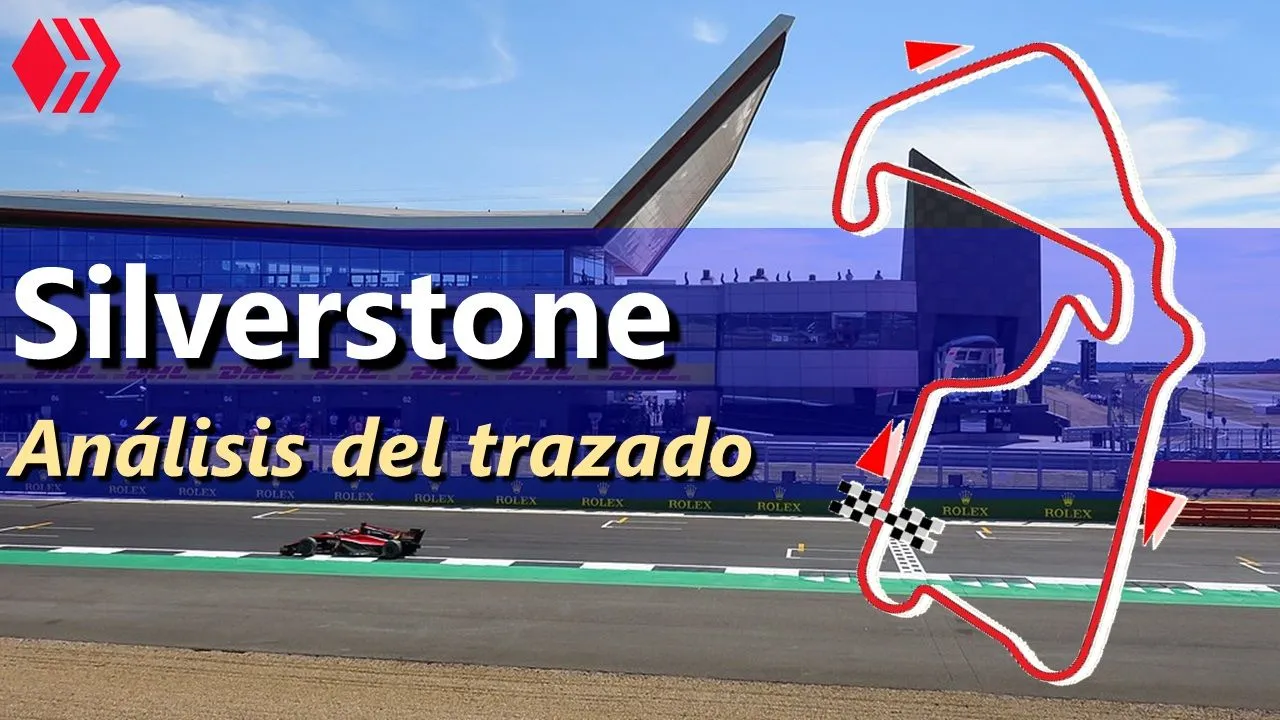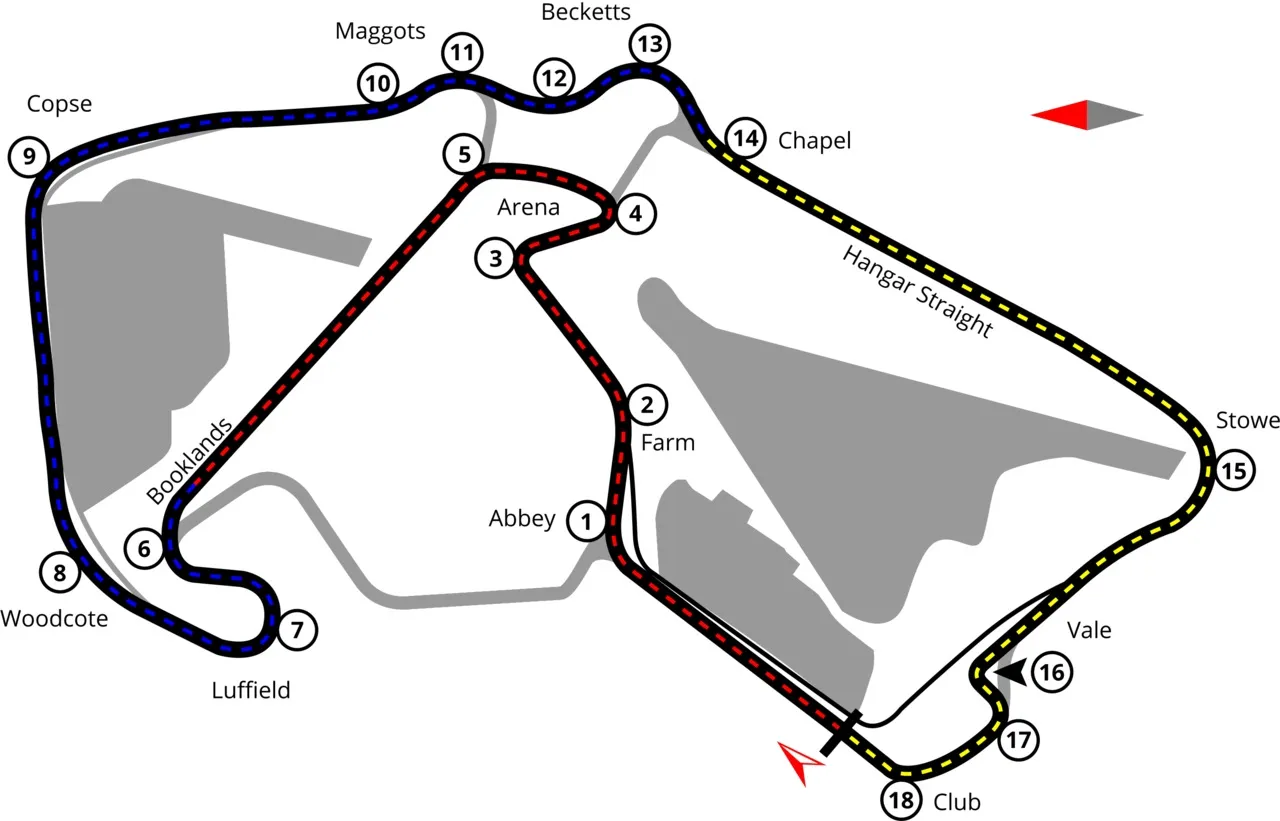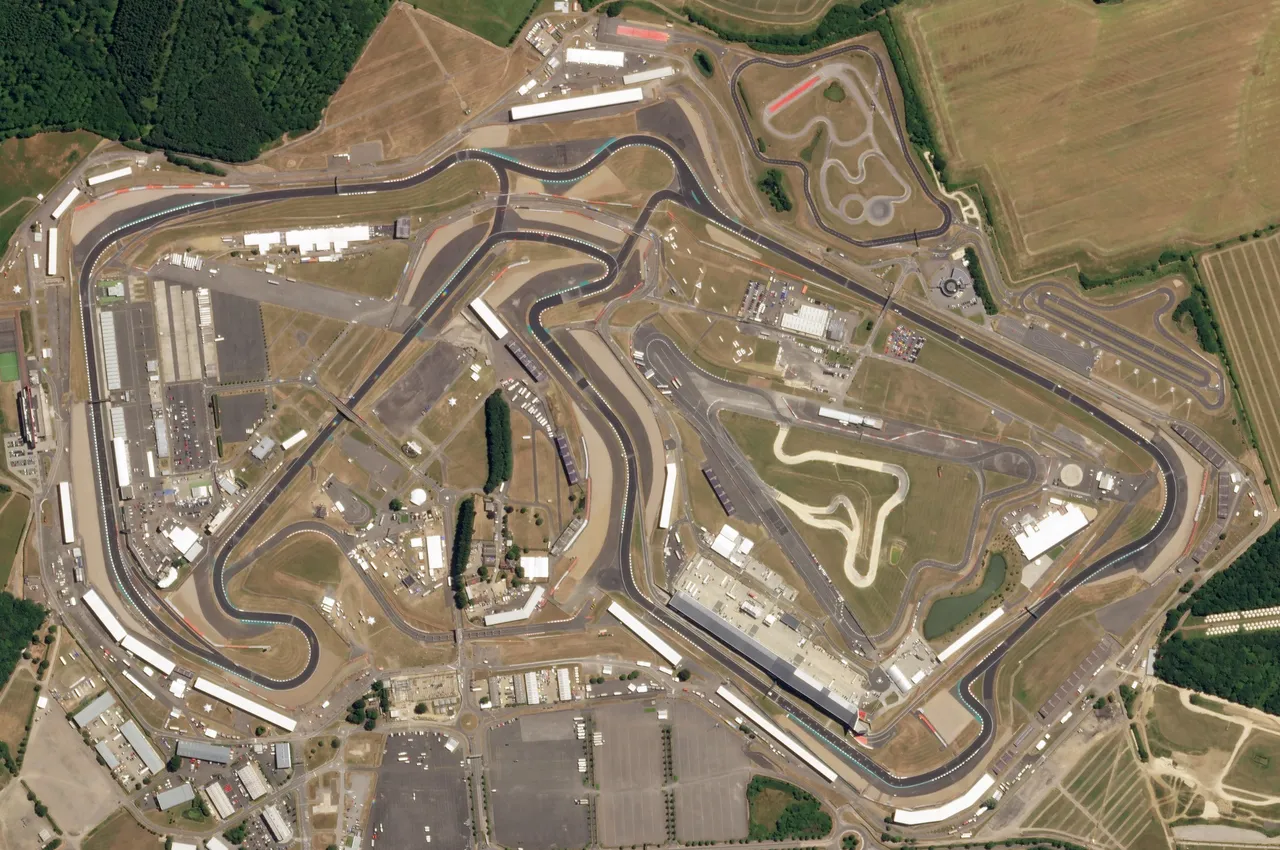El circuito de Silverstone es una de las joyas del automovilismo, siendo uno de los trazados más antiguos y legendarios de la máxima categoría. Este circuito se inauguró en el año 1947, luego de haber sido un aeródromo utilizado ne la segunda guerra mundial. Desde entonces, Reino Unido ha albergado sin interrupciones carreras de automovilismo de alta categoría, siendo la carrera de 1950 la primera carrera puntuable de la Fórmula 1.
The Silverstone circuit is one of the jewels of motor racing, being one of the oldest and most legendary tracks of the maximum category. This circuit was inaugurated in 1947, after having been an airfield used during the Second World War. Since then, the United Kingdom has hosted without interruption high class motor racing, being the 1950 race the first scoring race of Formula 1.

Silverstone ha sido la única sede del Gran Premio de Reino Unido, a excepción de ciertos años entre 1955 y 1986. Con el tiempo ha sufrido una gran cantidad de modificaciones en su trazado, pero siempre se ha caracterizado por ser un circuito con curvas muy rápidas y largas rectas, siendo uno de los mayores exponentes de los circuitos clásicos o de leyenda. En la siguiente imagen se observa el trazado actual, vigente desde el año 2010:
Silverstone has been the only Grand Prix venue in the United Kingdom, except for certain years between 1955 and 1986. Over time it has undergone a large number of modifications in its layout, but it has always been characterized for being a circuit with very fast curves and long straights, being one of the greatest exponents of the classic or legendary circuits. The following image shows the current layout, in use since 2010:


En la imagen siguiente se pueden observar todas las antiguas trazadas del circuito británico. Originalmente, los autos circulaban por el trazado gris, el circuito tenía forma de "X". Pero ya en 1949, se empezaba a correr por una trazada que empezaba a parecerce al trazado moderno, era un circuito simple con largas rectas y curvas redondeadas y muy rápidas (trazado negro).
Ya en 1991, el trazado moderno empezaba a evidenciarse (en azul). Dicho trazado se mantendría más o menos igual hasta 2009, con recurrentes modificaciones entre las curvas Brooklands y Luthfield. El trazado de 1997, aunque ya no se utiliza, nos recuerda mucho al Silverstone original.
Para 2010, se da una modificación radical al trazado que lo dejaría tal como lo vemos hoy (trazado rojo). La recta principal se movería de tal forma que "Club" sería la última curva. Tal como se ve en la imagen, me parece que este es el único circuito en tener 3 diferentes rectas principales en su historia.
Ya en 1991, el trazado moderno empezaba a evidenciarse (en azul). Dicho trazado se mantendría más o menos igual hasta 2009, con recurrentes modificaciones entre las curvas Brooklands y Luthfield. El trazado de 1997, aunque ya no se utiliza, nos recuerda mucho al Silverstone original.
Para 2010, se da una modificación radical al trazado que lo dejaría tal como lo vemos hoy (trazado rojo). La recta principal se movería de tal forma que "Club" sería la última curva. Tal como se ve en la imagen, me parece que este es el único circuito en tener 3 diferentes rectas principales en su historia.
In the following image you can see all the old layouts of the British circuit. Originally, the cars were running on the grey track, the circuit was in the shape of an "X". In 1949 they started to race on a layout that began to resemble the modern layout, it was a simple circuit with long straights and rounded and very fast curves (black layout).
Already in 1991, the modern layout began to be evident (in blue). This layout would remain more or less the same until 2009, with recurring modifications between the Brooklands and Luthfield corners. The 1997 layout, although no longer in use, is very reminiscent of the original Silverstone.
For 2010, a radical modification is given to the layout that would leave it as we see it today (red layout). The main straight would be moved in such a way that "Club" would be the last corner. As seen in the picture, it seems to me that this is the only circuit to have 3 different main straights in its history.
Already in 1991, the modern layout began to be evident (in blue). This layout would remain more or less the same until 2009, with recurring modifications between the Brooklands and Luthfield corners. The 1997 layout, although no longer in use, is very reminiscent of the original Silverstone.
For 2010, a radical modification is given to the layout that would leave it as we see it today (red layout). The main straight would be moved in such a way that "Club" would be the last corner. As seen in the picture, it seems to me that this is the only circuit to have 3 different main straights in its history.

La modificación del año 2010, más allá de cambiar un poco la forma original, mantiene muy bien la misma esencia. Es más, el trazado actual le brinda aún más velocidad y fluidez al circuito, aunque quizás al estilo "moderno", con dos horquillas algo lentas pero no tan trabadas, gracias a que la pista es bastante ancha. La primera curva es una de las más rápidas del calendario, algo que este circuito tenía que tener, ya que muchas de sus curvas son así.
The 2010 modification, beyond changing the original shape a little, keeps the same essence very well. Moreover, the current layout gives even more speed and fluidity to the circuit, although perhaps in a "modern" style, with two corners that are somewhat slow but not so tight, thanks to the fact that the track is quite wide. The first corner is one of the fastest on the calendar, something this circuit had to have, as many of its corners are like that.

La característica principal de este circuito son sus curvas de alta velocidad. Tal como caracteriza a los circuitos clásicos, nos encontramos con curvas redondeadas y muy rápidas, aunque no tenemos cambios de nivel importantes. Son muy famosas las curvas de Maggots, Beckets y Chapel, laa cuales nos recuerdan a Eau Rouge en Spa, pero sin cambios de nivel. Esto requiere cierta carga aerodinámica y agarre mecánico del auto, para tomarlas a buena velocidad sin perder en las rectas.
The main characteristic of this circuit is its high speed curves. As it characterizes the classic circuits, we find rounded and very fast curves, although we do not have important level changes. Very famous are the Maggots, Beckets and Chapel curves, which remind us of Eau Rouge in Spa, but without level changes. This requires a certain aerodynamic load and mechanical grip of the car, to take them at good speed without losing in the straights.

Copse es una curva muy rápida hacia la derecha, la cual anteriormente era la primera curva. Se traza pisando ligeramente el freno y tratando de no salirse por fuera a la salida y poder llegar a Maggots con buena velocidad. Es difícil adelantar acá, además de riesgoso si se intenta por dentro a la par con otro auto, por lo cual se ha visto con mucha polémica el incidente entre Max y Lewis el pasado Gran Premio. Esta curva (Copse) nos recuerda de los peligros de los curvones de alta velocidad, sobre todo estando el muro relativamente cerca.
Copse is a very fast right turn, which used to be the first turn. It's traced by lightly stepping on the brakes and trying not to run off the outside on the exit and be able to reach Maggots with good speed. It is difficult to overtake here, as well as risky if you try to overtake on the inside with another car, which is why the incident between Max and Lewis in the last Grand Prix was so controversial. This corner (Copse) reminds us of the dangers of high speed corners, especially when the wall is relatively close.

Stowe es una curva muy amplia, a la cual se llega a máxima velocidad desde la recta del hangar y brinda muchas oportunidades de adelantamiento. Al poseer un radio de giro mayor al de Copse, los adelantamientos son más fáciles y menos riesgosos, ya que se frena casi a fondo para tomarla, por lo que son frecuentes los cambios de posiciones en esta curva. Luego de esto, viene la zona del club, la cual brinda otra oportunidad de adelantamientos pero en una chicane lenta, y suelen haber incidentes acá debido a lo cerrada de esta. La última curva se traza casi a fondo, teniendo cuidado de no perder la tracción y despistarse, para salir a la recta principal con la mayor velocidad posible.
Stowe is a very wide curve, which is reached at maximum speed from the hangar straight and provides many overtaking opportunities. As it has a larger turning radius than Copse, overtaking is easier and less risky, since you brake almost hard to take it, so there are frequent changes of positions in this curve. After this, comes "Club", which provides another opportunity for overtaking but in a slow chicane, and there are often incidents here due to the tightness of this corner. The last corner is almost flat out, being careful not to lose traction and get lost, in order to exit to the main straight with the highest possible speed.

La zona de Brooklands y Luthfield suele dar paso a peleas muy apretadas y emocionantes por posición. Antiguamente era una zona más trabada, pero actualmente se llega a la curva Brooklands a gran velocidad desde la nueva recta, permitiendo mayor cantidad de sobrepasos. Hill y Schumascher, Alonso y Vettel, o Verstappen y Hamilton recientemente han transitado estas curvas mano a mano.
The Brooklands and Luthfield area usually gives way to very tight and exciting fights for position. It used to be a tighter area, but now Brooklands corner is approached at high speed from the new straight, allowing for more overtaking. Hill and Schumascher, Alonso and Vettel, or Verstappen and Hamilton have recently gone head to head in these corners.

Al ser una zona mucho más trabada que el resto del circuito, pero sin dejar de ser fluida, los autos llegan con posibilidades de construir maniobras de adelantamiento y salir a la siguiente recta con mayor velocidad. Aquí entra en juego la configuración mecánica del coche para aprovechar mejor las zonas lentas. En la siguiente foto se aprecia a Senna siendo transportado por Mansell en 1991, luego que el auto del Brasileño se quedara sin combustible al final de la carrera.
Being a much more difficult area than the rest of the circuit, but still fluid, the cars arrive with possibilities to build overtaking maneuvers and go out to the next straight with greater speed. Here comes into play the mechanical configuration of the car to take better advantage of the slower areas. The following photo shows Senna being carried by Mansell in 1991, after the Brazilian's car ran out of fuel at the end of the race.

En definitiva, SIlverstone es un circuito de leyenda, que ha conseguido mantenerse en el calendario con un aspecto renovado y brindando carreras muy emocionantes. Es un circuito que beneficia mucho a los mejores motores, pero donde la aerodinámica no se queda atrás. Debe procurarse mantener su esencia original, con curvones de alta velocidad, pero siempre teniendo la seguridad por delante, para evitar accidentes serios. En 2021 hemos visto una carrera con mucho movimiento, pero para 2022 probablemente se vea aún más movimiento, debido a las nuevas reglamentaciones de los coches.
In short, SIlverstone is a legendary circuit, which has managed to stay on the calendar with a renewed look and providing very exciting races. It is a circuit that greatly benefits the best engines, but where aerodynamics is not far behind. Efforts should be made to maintain its original essence, with high-speed corners, but always keeping safety first, to avoid serious accidents. In 2021 we have seen a race with a lot of movement, but 2022 will probably see even more movement, due to the new car regulations.
También te recomiendo visitar mi anterior publicación: Análisis del circuito Red Bull Ring (Austria)
I also recommend you to visit my previous post: Analysis of the Red Bull Ring circuit

Deja tu comentario o comparte (reblog) esta publicación si te ha parecido interesante.
Leave a comment or share (reblog) this post if you found it interesting.
Translated to English language with the help of DeepL.com
| ¡Gracias por visitar! — Deja tu comentario 🚥🏆  |
